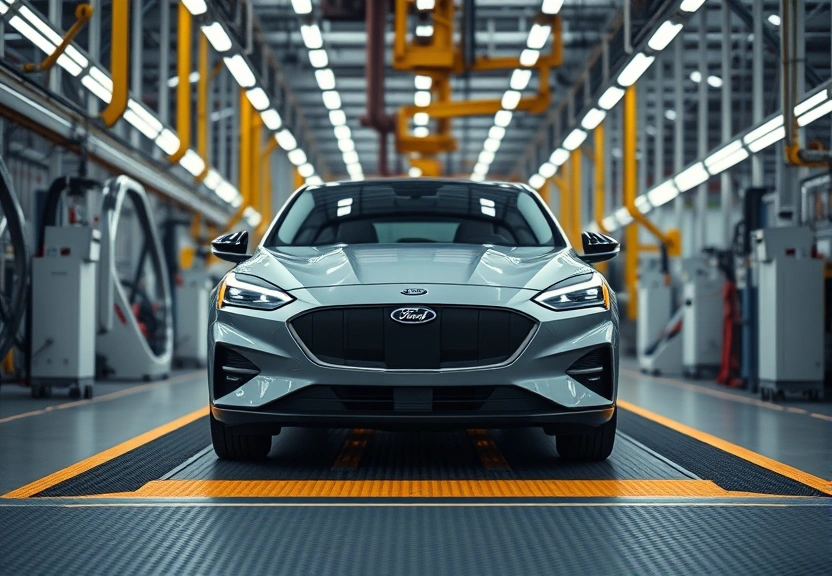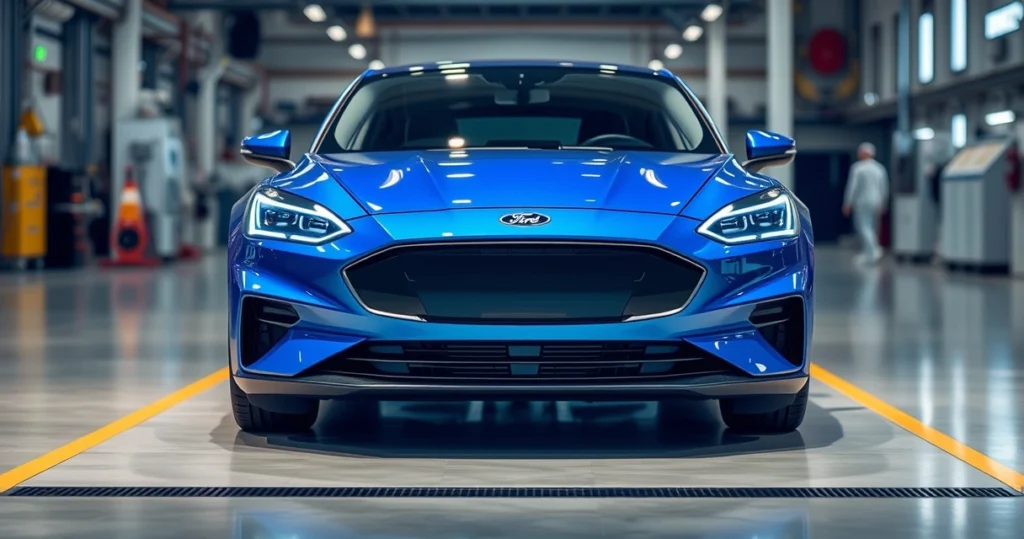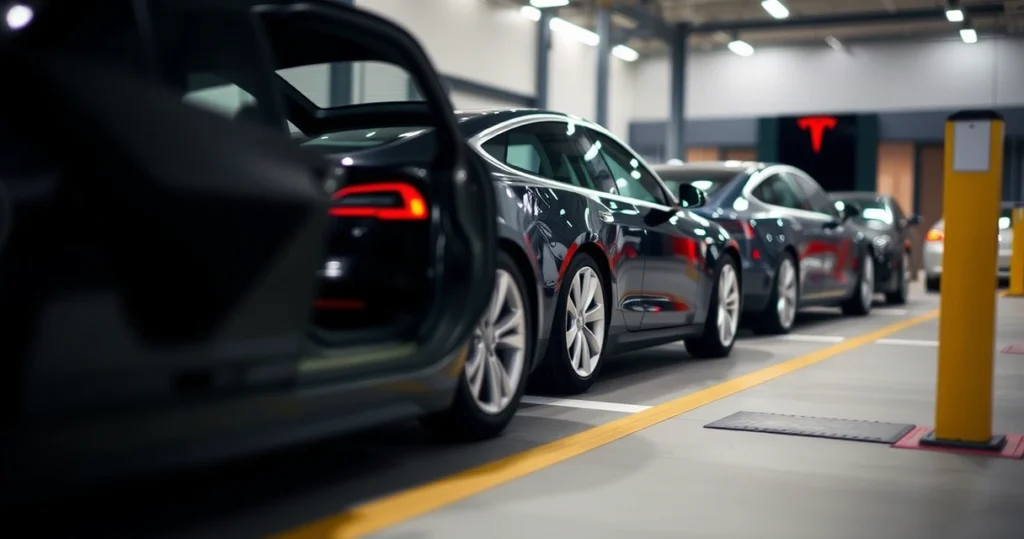Ford’s Bold Revolution: Transforming EV Manufacturing to Outpace China and Tesla
As the automotive industry enters a new era dominated by electric vehicles (EVs), Ford Motor Company is stepping up its game with a bold revolution in EV manufacturing. With billions of dollars committed to radical reinventions, Ford aims to not only keep pace with industry giants like Tesla but also to confront the growing competition from Chinese automakers. This strategic pivot underscores Ford’s commitment to innovation and sustainability in a rapidly evolving market.

Ford’s transformation reflects a broader trend in the automotive sector, where traditional manufacturers are racing to catch up with the pioneering advancements made by Tesla and the aggressive expansion of Chinese automotive brands. With its expansive plans, Ford is determined to carve out a significant share of the EV market, focusing on technology, production efficiency, and sustainable practices. In this article, we will delve into Ford’s revolutionary strategies, its competitive landscape, and what this means for the future of electric vehicles.
The Strategic Vision Behind Ford’s EV Manufacturing Shift
Ford’s transformation in EV manufacturing is driven by a clear strategic vision that encompasses several key areas: innovation, investment, and market positioning. The company’s leadership recognizes that to remain competitive, it must not only produce electric vehicles but also innovate in how these vehicles are manufactured and delivered.
Investment in Technology and Infrastructure
Ford is committing over $50 billion towards electric vehicle development through 2026. This investment is aimed at modernizing manufacturing facilities, enhancing research and development capabilities, and strengthening supply chains to support EV production. Ford’s investment is not just about building vehicles; it’s about creating a comprehensive ecosystem that supports EV technology from the ground up.
Collaboration and Partnerships
In its pursuit to become a leader in EV manufacturing, Ford is actively seeking partnerships with technology companies and startups specializing in battery technology and electric drivetrains. Collaborations with firms like SK On and CATL aim to secure a steady supply of batteries, which are crucial for EV production. By leveraging external expertise, Ford enhances its technological capabilities and accelerates its production timelines.
Confronting the Chinese Competition
The rise of Chinese automakers poses a significant challenge for traditional manufacturers like Ford. Companies such as BYD and NIO are rapidly gaining ground in the EV market, offering compelling products at competitive prices. To effectively confront this competition, Ford is adopting a multifaceted approach.
Local Manufacturing and Global Strategy
One of the key strategies Ford is implementing is local manufacturing. By establishing production facilities within key markets, Ford can reduce costs, shorten supply chains, and respond more quickly to consumer demands. This approach not only enhances Ford’s competitiveness against Chinese brands but also aligns with global sustainability initiatives by minimizing the carbon footprint associated with transportation.
Emphasizing Affordability and Accessibility
Ford’s recent push includes a focus on affordability and accessibility for its EV lineup. The company understands that to attract a broad consumer base, it must provide options that cater to various price points. The introduction of models like the Ford F-150 Lightning and the Mustang Mach-E demonstrates Ford’s commitment to making electric vehicles accessible to the average consumer while maintaining performance and style.
Competing with Tesla: Lessons and Innovations
Tesla has set the bar high in the electric vehicle market, not just in terms of sales but also in innovation and brand loyalty. Ford is looking to learn from Tesla’s successes while also carving its own niche in the market.
Enhancing Consumer Experience
Ford is focusing on enhancing the consumer experience through advanced technology integration. Features such as intuitive infotainment systems, over-the-air updates, and advanced driver-assistance systems are becoming standard in Ford’s EV offerings. By prioritizing user experience, Ford aims to attract customers who are accustomed to the tech-savvy features that Tesla vehicles provide.
Building a Strong Brand Identity
Ford’s rich heritage as an American automotive icon plays to its advantage. The company is leveraging its legacy to build a strong brand identity in the EV space. Marketing campaigns highlighting Ford’s commitment to sustainability, innovation, and American manufacturing resonate with consumers who value both heritage and modern technology.
Implementing Sustainable Practices in EV Manufacturing
As environmental concerns continue to rise, Ford is placing a significant emphasis on sustainability within its manufacturing processes. This is not only crucial for meeting regulatory standards but also for appealing to eco-conscious consumers.
Reducing Carbon Footprint
Ford is implementing various strategies to reduce its carbon footprint, including the use of renewable energy sources for manufacturing facilities. The company aims to achieve carbon neutrality globally by 2050, with interim goals set for 2035. This commitment to sustainability is essential for building trust and loyalty among consumers concerned about climate change.
Recycling and Reusing Materials
In addition to reducing emissions, Ford is focusing on recycling and reusing materials in its production processes. By utilizing recycled materials in vehicle components and promoting a circular economy, Ford is positioning itself as a leader in sustainable manufacturing practices, making it more competitive in the EV landscape.
Key Takeaways from Ford’s EV Revolution
- Ford is investing over $50 billion in EV manufacturing through 2026.
- Local manufacturing strategies are being employed to combat Chinese competition.
- Ford emphasizes affordability and accessibility in its EV lineup.
- Technological integration and enhanced consumer experience are key focuses.
- Sustainability is at the forefront of Ford’s operational strategies.
FAQs
1. What is Ford’s investment in EV manufacturing?
Ford is investing over $50 billion in electric vehicle development through 2026, focusing on modernizing facilities, enhancing R&D, and securing battery supplies.
2. How is Ford addressing competition from Chinese automakers?
Ford is establishing local manufacturing facilities and focusing on affordability and accessibility to effectively compete with Chinese brands like BYD and NIO.
3. What strategies is Ford implementing to compete with Tesla?
Ford is enhancing consumer experience through advanced technology, building a strong brand identity, and focusing on user-friendly features to attract customers.
4. What are Ford’s sustainability goals?
Ford aims to achieve global carbon neutrality by 2050, with interim goals set for 2035, and is implementing strategies to reduce its carbon footprint and recycle materials.
5. How does Ford plan to enhance consumer experience in its EVs?
Ford is integrating advanced technology, such as intuitive infotainment systems and driver-assistance features, to improve the overall user experience of its electric vehicles.
Conclusion
Ford’s bold revolution in EV manufacturing marks a significant step towards redefining the automotive landscape. By investing heavily in technology and infrastructure, addressing competitive challenges, and committing to sustainability, Ford is not only positioning itself as a formidable player in the electric vehicle market but also signaling a broader automotive revolution. As the company navigates the complexities of this transformation, it will be crucial to maintain a balance between innovation, affordability, and environmental responsibility. The coming years will be pivotal for Ford as it strives to outpace both Chinese competition and industry leader Tesla, ultimately shaping the future of electric mobility.
📰 Original Source
Este artigo foi baseado em informações de: https://www.wired.com/story/fords-answer-to-china-a-completely-new-way-of-making-cars/



